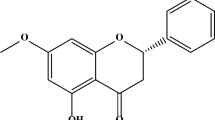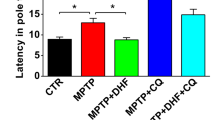Abstract
Parkinson’s disease (PD) is a progressive neurodegenerative disease associated with loss of dopaminergic neurons in the substantia nigra pars compacta. Although aging is the primary cause, environmental and genetic factors have also been implicated in its etiology. In fact, the sporadic nature of PD (i.e., unknown etiology) renders the uncovering of the exact pathogenic mechanism(s) or development of effective pharmacotherapies challenging. In search of novel neuroprotectants, we showed that butyrate (BUT), a short-chain fatty acid, protects against salsolinol (SALS)-induced toxicity in human neuroblastoma-derived SH-SY5Y cells, which are considered an in-vitro model of PD. Dihydromyricetin (DHM), a flavonoid derived from Asian medicinal plant, has also shown effectiveness against oxidative damage and neuroinflammation, hallmarks of neurodegenerative diseases. Here we show that pretreatment of SH-SY5Y cells with DHM concentration-dependently prevented SALS-induced toxicity and that a combination of DHM and BUT resulted in a synergistic protection. The effects of both DHM and BUT in turn could be completely blocked by flumazenil (FLU), a GABAA antagonist acting at benzodiazepine receptor site, and by bicuculline (BIC), a GABAA antagonist acting at orthosteric site. Beta-hydroxybutyrate (BHB), a free fatty acid 3 (FA3) receptor antagonist, also fully blocked the protective effect of DHM. BHB was shown previously to only partially block the protective effect of BUT. Thus, there are some overlaps and some distinct differences in protective mechanisms of DHM and BUT against SALS-induced toxicity. It is suggested that a combination of DHM and BUT may have therapeutic potential in PD. However, further in-vivo verifications are necessary.





Similar content being viewed by others
Availability of Data and Materials
A statement on how any datasets used can be accessed.
References
Cantu-Jungles TM, Rasmussen HE, Hamaker BR (2019) Potential of prebiotic butyrogenic fibers in Parkinson’s disease. Front Neurol 10:663. https://doi.org/10.3389/fneur.2019.00663
Carrera I, Fernandez-Novoa L, Sampedro C, Cacabelos R (2017) Neuroprotective effect of atremorine in an experimental model of Parkinson’s disease. Curr Pharm Des 23(18):2673–2684. https://doi.org/10.2174/1381612823666170210143530
Chua HC, Chebib M (2017) GABAA receptors and the diversity in their structure and pharmacology. Editor(s): Dominic P. Geraghty, Lachlan D. Rash. Adv Pharm. Academic Press 79:1–34. https://doi.org/10.1016/bs.apha.2017.03.003. Epub 2017 May 2
Copeland RL Jr, Das JR, Kanaan YM, Taylor RE, Tizabi Y (2007) Antiapoptotic effects of nicotine in its protection against salsolinol-induced cytotoxicity. Neurotox Res 12(1):61–69. https://doi.org/10.1007/BF03033901
Encinas M, Iglesias M, Liu Y, Wang H, Muhaisen A et al (2000) Sequential treatment of SH-SY5Y cells with retinoic acid and brain-derived neurotrophic factor gives rise to fully differentiated, neurotrophic factor-dependent, human neuron-like cells. J Neurochem 75(3):991–1003. https://doi.org/10.1046/j.1471-4159.2000.0750991.x
Fan L, Zhao X, Tong Q, Zhou X, Chen J et al (2018) Interactions of dihydromyricetin, a flavonoid from vine tea (Ampelopsis grossedentata) with gut microbiota. J Food Sci 83(5):1444–1453. https://doi.org/10.1111/1750-3841.14128. Epub 2018 Apr 16
Funakohi-Tago M, Sakata T, Fujiwara S, Sakakura A, Sugai T et al (2018) Hydroxytyrosol butyrate inhibits 6-OHDA-induced apoptosis through activation of the Nrf2/HO-1 axis in SH-SY5Y cells. Eur J Pharmacol 834:246–256. https://doi.org/10.1016/j.ejphar.2018.07.043. Epub 2018 Jul 24
Ge H, Guan S, Shen Y, Sun M, Hao Y et al (2019) Dihydromyricetin affects BDNF levels in the nervous system in rats with comorbid diabetic neuropathic pain and depression. Sci Rep 9(1):14619. https://doi.org/10.1038/s41598-019-51124-w
George K, Preuss CV, Sadiq NM (2022) GABA Inhibitors. In: StatPearls [Internet]. Treasure Island (FL): StatPearls Publishing; PMID: 31424814
Getachew B, Csoka AB, Aschner M, Tizabi Y (2019) Nicotine protects against manganese and iron-induced toxicity in SH-SY5Y cells: Implication for Parkinson's disease. Neurochem Int 124:19–24. https://doi.org/10.1016/j.neuint.2018.12.003
Getachew B, Csoka AB, Bhatti AC, Copeland RL, Tizabi Y (2020) Butyrate protects against salsolinol-induced toxicity in SH-SY5Y cells: implication for Parkinson’s disease. Neurotox Res 38:596–602. https://doi.org/10.1007/s12640-020-00238-5. Epub 2020 Jun 22
Getachew B, Csoka AB, Garden AR, Copeland RL, Tizabi Y (2021) Sodium butyrate protects against ethanol-induced toxicity in SH-SY5Y cell line. Neurotox Res 39(6):2186–2193
Getachew B, Csoka AB, Tizabi Y (2022) Dihydromyricetin protects against ethanol-induced toxicity in SH-SY5Y cell line: role of GABAA receptor. Neurotox Res 40(3):892–899. https://doi.org/10.1007/s12640-022-00503-9. Epub 2022 Apr 7
Getachew B, Hudson T, Heinbockel T, Csoka AB, Tizabi Y (2018) Protective effects of donepezil against alcohol-induced toxicity in cell culture: role of caspase-3. Neurotox Res 34(3):757–762. https://doi.org/10.1136/jnnp.2007.131045
Guo CH, Cao T, Zheng LT, Waddington JL, Zhen XC (2020) Development and characterization of an inducible Dicer conditional knockout mouse model of Parkinson’s disease: validation of the antiparkinsonian effects of a sigma-1 receptor agonist and dihydromyricetin. Acta Pharmacol Sin 41(4):499–507. https://doi.org/10.1038/s41401-020-0379-5. Epub 2020 Feb 28
Inoue D, Tsujimoto G, Kimura I (2014) Regulation of energy homeostasis by GPR41. Front Endocrinol (Lausanne) 5:1–3. https://doi.org/10.3389/fendo.2014.00081
Jankovic J (2008) Parkinson’s disease: clinical features and diagnosis. J Neurol Neurosurg Psychiatry 79(4):368–376. https://doi.org/10.1136/jnnp.2007.131045
Jia L, Wang Y, Sang J, Cui W, Zhao W et al (2019) Dihydromyricetin inhibits α-synuclein aggregation, disrupts preformed fibrils, and protects neuronal cells in culture against amyloid-induced cytotoxicity. J Agric Food Chem 67(14):3946–3955. https://doi.org/10.1021/acs.jafc.9b00922. Epub 2019 Mar 29
Johnston GA (2013) Advantages of an antagonist: bicuculline and other GABA antagonists. Br J Pharmacol 169(2):328–336. https://doi.org/10.1111/bph.12127
Kimura I, Inoue D, Maeda T, Hara T, Ichimura A et al (2011) Short-chain fatty acids and ketones directly regulate sympathetic nervous system via G protein-coupled receptor 41 (GPR41). Proc Natl Acad Sci USA 108:8030–8510. https://doi.org/10.1073/pnas.1016088108. Epub 2011 Apr 25
Korsten SGPJ, Peracic L, van Groeningen LMB, Diks MAP, Vromans H et al (2022) Butyrate prevents induction of CXCL10 and non-canonical IRF9 expression by activated human intestinal epithelial cells via HDAC inhibition. Int J Mol Sci 23(7):3980. https://doi.org/10.3390/ijms23073980
Landis HE, Getachew B, Tizabi Y (2022) Therapeutic potential of flavonoids and zinc in COVID-19. Medpress Nutr Food Sci 1(1):202111001. Epub 2021 Dec 31
Li H, Li Q, Liu Z, Yang K, Chen Z et al (2017) The versatile effects of dihydromyricetin in health. Evid Based Complement Alternat Med 1053617. https://doi.org/10.1155/2017/1053617. Epub 2017 Aug 30
Liu J, Wang F, Liu S, Du J, Hu X et al (2017) Sodium butyrate exerts protective effect against Parkinson’s disease in mice via stimulation of glucagon like peptide-1. J Neurol Sci 381:176–181. https://doi.org/10.1016/j.jns.2017.08.3235. Epub 2017 Aug 24
Martínez-Coria H, Mendoza-Rojas MX, Arrieta-Cruz I, López-Valdés HE (2019) Preclinical research of dihydromyricetin for brain aging and neurodegenerative diseases. Front Pharmacol 10:1334. https://doi.org/10.3389/fphar.2019.01334
Niewiarowska-Sendo A, Patrzalek K, Kozik A, Guevara-Lora I (2015) The effect of differentiation agents on inflammatory and oxidative responses of the human neuroblastoma cell line SK-N-SH. Acta Biochim Pol 62(3):435–443. https://doi.org/10.18388/abp.2015_1039. Epub 2015 Aug 18
Olsen RW (2018) GABAA receptor: positive and negative allosteric modulators. Neuropharmacology 136(Pt A):10–22. https://doi.org/10.1016/j.neuropharm.2018.01.036. Epub 2018 Jan 31
Qian J, Wang X, Cao J, Zhang W, Lu C et al (2021) Dihydromyricetin attenuates D-galactose-induced brain aging of mice via inhibiting oxidative stress and neuroinflammation. Neurosci Lett 756:135963. https://doi.org/10.1016/j.neulet.2021.135963. Epub 2021 May 19
Ren ZX, Zhao YF, Cao T, Zhen XC (2016) Dihydromyricetin protects neurons in an MPTP-induced model of Parkinson’s disease by suppressing glycogen synthase kinase-3 beta activity. Acta Pharmacol Sin 37(10):1315–1324. Erratum in: Acta Pharmacol Sin. 2017 May;38(5):733. https://doi.org/10.1038/aps.2016.42. Epub 2016 Jul 4. Erratum in: Acta Pharmacol Sin. 2017 May;38(5):733
Sharbaf Shoar N, Bistas KG, Saadabadi A (2022) Flumazenil. In: StatPearls [Internet]. Treasure Island (FL): StatPearls Publishing. PMID: 29262246
Silva J, Carry E, Xue C, Zhang J, Liang J, Roberge JY et al (2021) A novel dual drug approach that combines ivermectin and dihydromyricetin (DHM) to reduce alcohol drinking and preference in mice. Molecules 26(6):1791. https://doi.org/10.3390/molecules26061791
Sola P, Krishnamurthy PT, Kumari M, Byran G, Gangadharappa HV et al (2022) Neuroprotective approaches to halt Parkinson’s disease progression. Neurochem Int 158:105380. https://doi.org/10.1016/j.neuint.2022.105380. Epub 2022 Jun 17
Stilling RM, Van de Wouw M, Clarke G, Stanton C, Dinan TG, Cryan JF (2016) The neuropharmacology of butyrate: the bread and butter of the microbiota-gut-brain axis? Neurochem Int 99:110–132. https://doi.org/10.1016/j.neuint.2016.06.011. Epub 2016 Jun 23
Sveinbjornsdottir S (2016) The clinical symptoms of Parkinson’s disease. J Neurochem 139(Suppl 1):318–324. https://doi.org/10.1111/jnc.13691. Epub 2016 Jul 11
Teleanu DM, Niculescu AG, Lungu II, Radu CI, Vladâcenco O et al (2022) An overview of oxidative stress, neuroinflammation, and neurodegenerative diseases. Int J Mol Sci 23(11):5938. https://doi.org/10.3390/ijms23115938
Tizabi Y, Getachew B, Aschner M (2021) Novel pharmacotherapies in Parkinson’s disease. Neurotox Res 39(4):1381–1390. https://doi.org/10.1007/s12640-021-00375-5. Epub 2021 May 18
Tizabi Y, Getachew B, Copeland RL, Moratalla R, Patricio F et al (2021a) Novel pharmacotherapies for L-DOPA-induced dyskinesia. In: Kostrzewa RM (eds) Handbook of Neurotoxicity. Springer Cham 1–19. https://doi.org/10.1007/978-3-030-71519-9_218-1
Ulven T (2012) Short-chain free fatty acid receptors FFA2/GPR43 and FFA3/GPR41 as new potential therapeutic targets. Front Endocrinol (lausanne) 3:111. https://doi.org/10.3389/fendo.2012.00111
Wang Y, Wang J, Xiang H, Ding P, Wu T et al (2022) Recent update on application of dihydromyricetin in metabolic related diseases. Biomed Pharmacother 148:112771. https://doi.org/10.1016/j.biopha.2022.112771. Epub 2022 Mar 2
Wei C, Chen X, Chen D, Yu B, Zheng P et al (2022) Dihydromyricetin enhances intestinal antioxidant capacity of growing-finishing pigs by activating ERK/Nrf2/HO-1 signaling pathway. Antioxidants (basel) 11(4):704. https://doi.org/10.3390/antiox11040704
Whitwam JG, Amrein R (1995) Pharmacology of flumazenil. Acta Anaesthesiol Scand Suppl 108:3–14. https://doi.org/10.1111/j.1399-6576.1995.tb04374.x
Funding
The study was supported by NIH/NIAAA R03AA022479 (Y. T.) and NIH/NIA 1R25AG047843-01 (A. B. C., K. F. M.).
Author information
Authors and Affiliations
Contributions
All authors confirmed they have contributed to the intellectual content of this paper including significant contributions to the conception and design, acquisition of data, or analysis and interpretation of data; drafting or revising the article for intellectual content; final approval of the published article; and agreement to be accountable for all aspects of the article. The initial concept was developed by Y. T. and discussed with all other co-authors. Cell culture studies were conducted by B. G. and A. B. C. Interpretation and data analysis were done by Y. T., B. G., A. B. C., R. L. C., and K. F. M. All authors contributed to the writing of the final draft.
Corresponding author
Ethics declarations
Ethical Approval
Applicable for both human and/ or animal studies. Ethical committees, Internal Review Boards, and guidelines followed must be named. When applicable, additional headings with statements on consent to participate and consent to publish are also required.
Competing Interests
The authors declare no competing interests.
Additional information
Publisher's Note
Springer Nature remains neutral with regard to jurisdictional claims in published maps and institutional affiliations.
Rights and permissions
Springer Nature or its licensor (e.g. a society or other partner) holds exclusive rights to this article under a publishing agreement with the author(s) or other rightsholder(s); author self-archiving of the accepted manuscript version of this article is solely governed by the terms of such publishing agreement and applicable law.
About this article
Cite this article
Getachew, B., Csoka, A.B., Copeland, R.L. et al. Dihydromyricetin Protects Against Salsolinol-Induced Toxicity in Dopaminergic Cell Line: Implication for Parkinson’s Disease. Neurotox Res 41, 141–148 (2023). https://doi.org/10.1007/s12640-022-00631-2
Received:
Revised:
Accepted:
Published:
Issue Date:
DOI: https://doi.org/10.1007/s12640-022-00631-2




